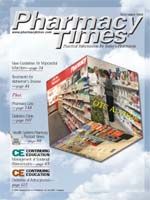Publication
Article
Pharmacy Times
RxPRODUCT NEWS PROFILE: Palladone (hydromorphone extended-release capsules)
Palladone, manufactured by PurduePharma LP, has been approved in theUnited States for the management ofpersistent moderate-to-severe pain inpatients requiring continuous around-the-clock opioid pain relief for anextended period of time. The drug isappropriate for patients requiring highdoses of potent opioid analgesics forpain relief, such as patients witharthritis.1 According to an FDA TalkPaper, "Palladone offers a therapeuticchoice for opioid-tolerant patientswho otherwise might be candidates forother opioids and who do not achievesatisfactory therapeutic results withother products."2
Pharmacology
Hydromorphone, the active ingredientin Palladone, is a semisyntheticcongener of morphine. It is a pure opioidagonist with a primary therapeuticaction of analgesia. It binds to opiatereceptors in the central nervous system(CNS), causing the inhibition ofascending pain pathways. The result isa diminished awareness of and reactionto pain.3
Clinical Trials
In a double-blind, randomized,placebo-controlled trial, Palladone wasstudied in patients experiencing painfor at least a month due to musculoskeletaldisorders. The patientsincluded were maintained on one ormore opioid analgesics, most likely inaddition to nonopioid analgesics.After it was determined that patientsneeded approximately 12 mg of immediate-release hydromorphone aroundthe clock to improve analgesia, 210patients with chronic moderate-to-severepain were randomized toreceive either Palladone 12 mg oncedaily or placebo.
The results showed better analgesiccontrol for a longer period of time inthe Palladone group, compared withthe placebo group (P >.0001). Theseresults demonstrated that, in this studiedpatient population, Palladone capsuleswere superior in managing paincontrol, when compared with placebo.1
Safety
FDA officials recommend the use ofPalladone only in patients who alreadyare taking opioid analgesics andrequire at least 12 mg of oral hydromorphoneor equivalent medication.1,2Purdue Pharma LP issued a boxedwarning for the product, stating thatPalladone is recommended in patientsrequiring all-day therapy who have difficultycontrolling pain with immediate-release opioid formulations.1
Common adverse reactions to Palladoneinclude headache, asthenia, constipation,nausea, and vomiting. Seriousadverse events with Palladone are similarto those produced by other productscontaining hydromorphone and otheropioid analgesics. Examples of suchevents include respiratory depression,apnea, and respiratory arrest. Therefore,this product should be used only inthose who are opioid-tolerant. Lesscommon serious events include circulatorydepression, hypotension, andshock or cardiac arrest.1,2
Palladone is not recommended forpatients who require opioid analgesiafor a short period of time. It also shouldnot be used on an as-needed basis.Patients concurrently taking other opioidanalgesics, phenothiazines, tricyclicantidepressants, or other CNSdepressants may experience additionalCNS effects. Palladone doses in thesecases should be adjusted accordinglyand side effects more intensely monitored.The use of histamine2 receptorblockers or proton pump inhibitorsdoes not affect Palladone steady-statepharmacokinetics.1
Outlook
Palladone is a Schedule II controlledsubstance. It is available as 12-, 16-, 24-,and 32-mg extended-release capsules.1Although Palladone should not be prescribedas the first agent used to controlpain, it offers an additional option forpatients not achieving appropriate therapeuticresults with other opioids.1,2
Drs. Faria and Soo are both senior researchpharmacists for the Investigational DrugService at Brigham and Women's Hospital,Boston, Mass. Dr. Faria also is a seniorhuman research specialist at PartnersHealthCare System.
For a list of references, send astamped, self-addressed envelope to:References Department, Attn. A. Stahl,Pharmacy Times, 241 Forsgate Drive,Jamesburg, NJ 08831; or send an e-mailrequest to: astahl@mwc.com.







